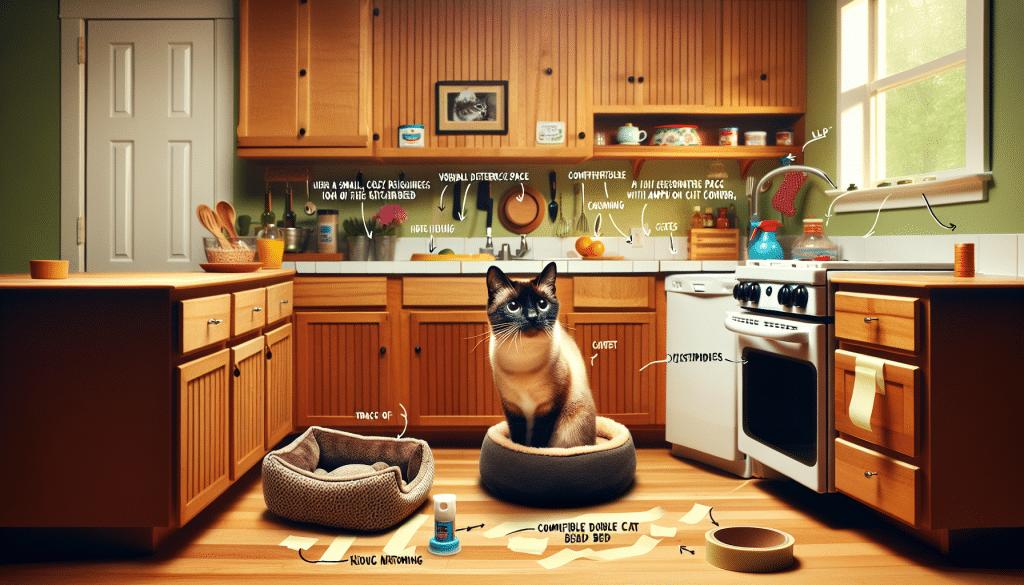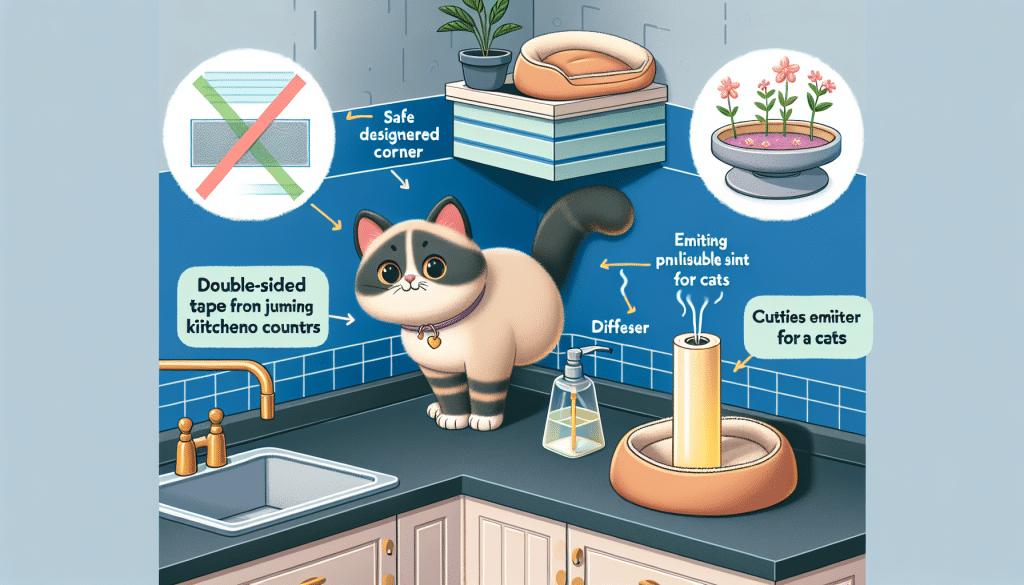So, you love your furry feline friend but can’t seem to prevent them from leaping onto your kitchen countertop? Well, fear not, because we’ve got you covered with these ten foolproof tactics to deter your mischievous cat from ever setting paw on your pristine counter again. From creating enticing alternative surfaces to employing specific deterrents, we’ve got all the tips and tricks to make your countertops a forbidden territory for your curious kitty. Get ready to take back control of your kitchen and say goodbye to unwanted cat paw prints on your clean, food preparation space!

Understanding the Behavior
Why do cats jump on counters?
Cats are naturally curious animals, and their jumping behavior often stems from their instinctual desire to explore their surroundings. Countertops provide elevated vantage points that allow cats to observe their environment more effectively. Additionally, cats may jump on counters in search of food or simply to satisfy their curiosity. Understanding the reasons behind this behavior is crucial in finding effective solutions to keep your cat off the counter.
Understanding the hunting instincts
Cats are natural predators, and their hunting instincts drive them to leap onto elevated surfaces to gain a better view of potential prey. In the wild, cats would climb trees or rocks to stalk their prey from above. This instinctual behavior remains strong in domestic cats, causing them to feel compelled to climb onto kitchen counters to survey their surroundings for any signs of movement. Recognizing and respecting these innate hunting instincts is vital in finding suitable alternatives for your cat to fulfill its natural desires.
Understanding the comfort and curiosity factor
Counters offer a comfortable and secluded spot for cats to relax and observe their surroundings without being disturbed. The elevated position of the counter may make cats feel secure, allowing them to snooze or simply enjoy a moment of solitude. Additionally, cats are naturally curious creatures, and the allure of forbidden areas like kitchen counters can be irresistible. The interesting smells, potential food scraps, and the ability to explore new heights make the counter a prime location for satisfying a cat’s curiosity. By understanding these factors, you can address your cat’s needs while also maintaining a tidy and safe kitchen environment.
Clear the Counters
Removing items that attract the cat
One effective method to deter your cat from jumping on the counter is to remove any items that are appealing to them. Ensure that countertops are free of food scraps or crumbs that might entice your cat to explore further. By eliminating the temptation, you are reducing the likelihood of your cat being drawn to the counter in the first place. Consistently wiping down your counters and promptly cleaning up after cooking or eating will significantly decrease your cat’s interest in this elevated space.
Never leaving food unattended
Leaving food unattended on the counter is an open invitation for your cat to jump up and investigate. Cats have a keen sense of smell and can detect even the faintest scent of food. To discourage your cat from counter-surfing, always supervise your food preparation, and refrain from leaving any food unattended. If you need to step away from the kitchen briefly, ensure that all food is securely stored away in airtight containers or placed in the refrigerator. By removing the accessibility of food, you are eliminating the motivation for your cat to jump on the counter.
Keeping the counter surface clean and clear
In addition to removing food items, it is important to keep the counter surface clean and free of any clutter. Cats are naturally curious and may investigate any objects left on the counter, assuming they are fair game for play. By clearing off the countertops and keeping them unobstructed, you are removing potential enticements and discouraging your cat from jumping up. A tidy counter also makes it easier for you to detect any future counter-jumping attempts and address the behavior promptly.

Invest In Cat Trees and Shelves
Introducing cat trees and high shelves
Providing your cat with an alternative elevated space, such as a cat tree or high shelves, can redirect their jumping behavior away from the countertops. Cat trees offer multiple levels for climbing, perching, and scratching, providing an enticing vertical playground for your feline friend. Similarly, installing high shelves or wall-mounted perches can give your cat a safe and designated area to observe their surroundings. By offering these designated spaces, you are satisfying their natural instinct to be up high while also preserving your counters.
Choosing the right location
When introducing cat trees or shelves, it is important to consider the ideal positioning. Place the cat tree or shelves near a window or in an area where your cat spends a lot of time. Cats enjoy having a view of the outside world and will be more likely to choose these elevated spots over the kitchen counter. Additionally, ensure that the cat tree or shelves are stable and secure to prevent any accidents or injuries. By strategically placing these alternative surfaces, you are providing your cat with an enticing substitute for the kitchen counter.
Training your cat to use the tree or shelf
While introducing cat trees and shelves can help redirect your cat’s attention away from the counters, it may be necessary to train them to use these new surfaces. Start by enticing your cat with treats or toys to encourage them to explore the cat tree or shelves. Place treats or toys on the elevated surfaces to create positive associations and reward your cat for using the designated spaces. Over time, your cat will learn that these areas are more desirable than the kitchen counter, and their jumping behavior will gradually diminish.
Using Deterrents
Using commercial deterrent sprays
Commercial deterrent sprays are available to help discourage your cat from jumping on the counter. These sprays are formulated with scents that cats find repulsive, such as citrus or bitter apple. Simply spray the deterrent on the countertops, focusing on the areas your cat tends to frequent. The unpleasant scent will deter your cat from jumping up and should gradually train them to avoid the counter altogether. It is crucial to choose a cat-safe deterrent spray and follow the instructions for safe usage.
Cats’ dislike for certain smells
Cats have highly sensitive noses and are often repelled by certain scents. By strategically placing items with these scents on your counter, you can deter your cat from jumping up. Consider using citrus-scented cleaning products, vinegar-soaked cotton balls, or even placing orange peels on the counter. These scents are known to be unappealing to cats and should discourage them from exploring the counter space. Experiment with different scents to find the one that works best for your cat.
Homemade DIY deterrents
If you prefer a natural and cost-effective approach, you can create your own DIY deterrents to keep your cat off the counter. Mixing water with citrus essential oils or creating a mixture of vinegar and water can serve as effective repellents when sprayed on the counter. Additionally, aluminum foil or double-sided tape can be placed on the counter surface. The strange texture and crinkling sound when touched can deter cats from jumping up. Remember to test any homemade deterrents in a small, inconspicuous area first to ensure they do not damage the countertop surface.

Implementing Training Techniques
Using clicker training
Clicker training can be an effective method to teach your cat to avoid jumping on the counter. Start by conditioning your cat to associate the sound of the clicker with a reward, such as a treat or praise. Whenever your cat approaches the counter but does not jump up, click and reward them. This positive reinforcement helps your cat understand that staying off the counter is desired behavior. Through consistent clicker training sessions, your cat will begin to associate the counter with pleasant rewards, reinforcing their decision to stay down.
Reinforcing positive behavior with rewards
Rewarding your cat for displaying desirable behavior reinforces their good habits and encourages them to continue making those choices. Whenever you catch your cat avoiding the counter and using designated surfaces instead, offer praise, petting, or a treat as a reward. Positive reinforcement creates a strong association between desired behavior and rewards, increasing the likelihood that your cat will repeat the behavior in the future. By consistently rewarding your cat for choosing appropriate spots to perch, you can effectively discourage counter-jumping behavior.
Quick and effective responses to jumping behavior
In addition to positive reinforcement, it is essential to respond quickly and effectively whenever your cat attempts to jump on the counter. A loud noise, such as clapping your hands or using a pet-safe air horn, can startle your cat and discourage the behavior. You can also try gently but firmly saying “no” when your cat jumps up and promptly redirecting them to an appropriate area, such as their cat tree or a designated perch. Immediate responses to jumping behavior help convey to your cat that the counter is off-limits while providing clear alternatives for them.
Incorporating Cat-proofing Tools
Using scat mats or sticky tape
Scat mats or sticky tape can be used as physical deterrents to keep your cat off the counter. Scat mats deliver a harmless static pulse when your cat touches them, teaching them to avoid the mat and, by extension, the counter. Sticky tape, such as double-sided tape or specialized cat deterrent tape, can also be effective in deterring jumping behavior. Cats dislike the sticky texture on their paws and will avoid areas covered in it. Regularly using these tools helps condition your cat to associate the counter with unpleasant experiences and dissuades them from jumping up.
Employing motion sensor air sprays
Motion sensor air sprays are an effective way to deter your cat from jumping on the counter. These devices are equipped with motion sensors that detect your cat’s presence and release a harmless burst of air, startling them and discouraging further attempts to access the counter. Place the motion sensor air spray near the edge of the counter or in areas where your cat tends to jump up. Over time, your cat will learn to associate the counter with the sudden burst of air and opt for alternative areas instead.
Introducing noise deterrents
Cats are sensitive to certain sounds, which can be utilized as a deterrent to keep them off the counter. Install noise deterrents, such as motion-activated alarms, that emit a high-pitched sound when triggered by your cat’s movement. This unexpected noise startles your cat and discourages counter-jumping. Another option is using white noise machines or leaving the radio on when you are not in the kitchen. These continuous background sounds can create an environment that cats find uninviting, making them less inclined to jump on the counter.
Adapting Feeding Practices
Ensuring your cat is well fed
One of the reasons cats may jump on the counter is to access food. Ensuring that your cat is well-fed with appropriate meals throughout the day can help reduce their motivation to search for food on the counter. Follow recommended feeding guidelines based on your cat’s age, weight, and health condition. A satisfied cat is less likely to display counter-jumping behavior.
Following a feeding schedule
Establishing a regular feeding schedule helps set boundaries and reduces the possibility of your cat becoming hungry and seeking out alternative food sources on the counter. Feed your cat at the same times each day, and avoid leaving food out for extended periods. By maintaining a consistent feeding routine, you are promoting a sense of security and predictability, decreasing the likelihood of your cat jumping onto the counter in search of food.
Keeping feeding areas separate from counters
Creating designated feeding areas for your cat can help reinforce the boundaries between the counter and appropriate spaces for food consumption. Place your cat’s food and water bowls in a separate area away from the kitchen counter, such as a corner of the room or a designated feeding station. By providing a clear distinction between the counter and the feeding area, you are reducing the likelihood of your cat associating the counter with food and deterring their jumping behavior.
Increase Playtime and Exercise
Keeping your cat physically and mentally stimulated
Cats often display counter-jumping behavior out of boredom or a lack of mental and physical stimulation. Ensuring that your cat receives sufficient playtime and exercise can help redirect their energy and provide an alternative outlet for their natural instincts. Engaging your cat in interactive play sessions using toys that mimic prey can help satisfy their hunting instincts. Additionally, providing environmental enrichment, such as puzzle toys or treat-dispensing toys, encourages mental stimulation and reduces boredom.
Playing with your cat more frequently
Increasing the frequency and duration of play sessions with your cat is an effective way to divert their attention away from the counter. Dedicate regular time each day to engage in interactive play, using toys that encourage jumping, pouncing, and chasing. By providing a stimulating and engaging play experience, you are promoting a stronger bond with your cat while simultaneously reducing their desire to jump on the counter.
Providing a variety of interactive toys
Offering a wide selection of interactive toys can help keep your cat entertained and satisfied. Toys that encourage climbing, jumping, and scratching can redirect their energy and prevent them from seeking out the counter as a source of amusement. Experiment with different types of toys, such as feather wands, laser pointers, or puzzle toys, to find what captures your cat’s interest the most. By providing a variety of toys, you are catering to your cat’s individual preferences and promoting a more mentally and physically engaged lifestyle.
Monitor Health Issues
Regular veterinary check-ups
It is important to ensure your cat’s overall health and well-being to address any underlying medical conditions that may contribute to counter-jumping behavior. Regular veterinary check-ups allow for early detection and management of any existing health issues. Certain medical conditions, such as hyperthyroidism or arthritis, can cause increased restlessness, discomfort, or excessive activity, potentially leading to counter-jumping behavior. By proactively monitoring your cat’s health, you can address any medical concerns and alleviate potential triggers for counter-surfing.
Understanding and dealing with behavioral issues
Counter-jumping may sometimes be a manifestation of underlying behavioral issues. Stress, anxiety, or territorial disputes with other pets in the household can contribute to this behavior. Observing your cat’s behavior and consulting with a veterinarian or animal behaviorist can help you identify any underlying emotional triggers. They can provide recommendations or suggest behavior modification techniques to address these issues and reduce counter-jumping behavior.
Maintaining a healthy diet and weight for your cat
Maintaining a healthy diet and weight is essential for your cat’s overall well-being. Obesity or nutritional imbalances can lead to behavioral issues, including increased counter-surfing behavior. Consult with your veterinarian to ensure that your cat is receiving a balanced and appropriate diet tailored to their age and health condition. By providing optimal nutrition and managing their weight, you are promoting a healthier lifestyle and potentially reducing the motivation for your cat to jump on the counter.
Practice Patience and Consistency
Understanding it is a gradual process
Addressing counter-jumping behavior in cats requires time, patience, and consistency. Cats are creatures of habit, and changing their behavior patterns takes time. Recognize that progress may be gradual, and setbacks may occur. Consistently implementing the strategies and techniques outlined earlier will help reinforce positive behaviors over time and eventually reduce or eliminate counter-jumping behavior. Stay committed to the process and remain understanding throughout your cat’s learning journey.
Staying consistent with training and deterrent application
Consistency is key when training your cat to refrain from jumping on the counter. Ensure that all household members follow the same rules and consistently enforce the same behaviors. Reinforce positive behavior, redirect or deter counter-jumping, and promptly address any attempts to jump up. Regularly apply deterrents, maintain feeding routines, and provide environmental enrichment consistently. By maintaining a consistent approach, your cat will learn to associate the counter with negative experiences and alternative spaces with positive reinforcement.
Adapting and tweaking methods based on success
Every cat is unique, and what works for one may not work for another. It is essential to observe and evaluate the effectiveness of the strategies you employ. If a particular method is not yielding positive results, be open to adaptation and experimentation. Try different deterrent techniques, adjust the positioning of cat trees or shelves, or modify playtime routines to better suit your cat’s preferences. By continuously assessing and adapting your approach, you can tailor the methods to best suit your individual cat’s needs and increase the chances of success in deterring counter-jumping behavior.
Remember, keeping your cat off the counter requires a combination of understanding their behaviors, providing suitable alternatives, consistent training, and addressing any underlying health or behavioral issues. By implementing these strategies and techniques, you can create a harmonious and cat-friendly living environment while preserving the cleanliness and safety of your kitchen. With patience, consistency, and a willingness to adapt, you can establish a positive and rewarding relationship with your cat while curbing their counter-jumping tendencies.



